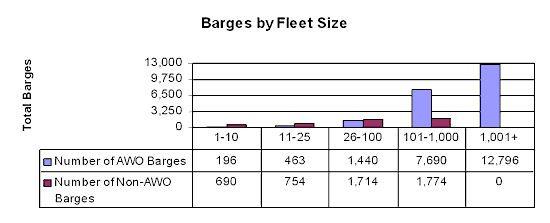|
Barges

Courtesy of
Coosa-Alabama River Improvement Association, Inc.
|
The development of river commerce along the principle arteries of trade in North
America demanded a need for an efficient shipping container for that trade. American
river barges developed into their current form around 1840. The first barges where wooden-hand crafted boxes,
sealed with tar to prevent water leakage. These rudimentary barges used for shipping
raw materials quickly deteriorated. Today American river barges are manufactured
out of steel and can often be utilized for over fifty years.
Barges are efficient and adaptable for transporting bulk materials. One barge has
the ability to transport five times its own weight, the equivalent of 15 railcars or 58 trucks. The use of barges is also extremely
fuel efficient. This allows for the transport of as many as 40 to 50 being pushed by one large towboat on the Mississippi
below St. Louis. |
There are a variety of barges on the river system. Approximately 26,000 barges are used for dry cargo; with the standard
“Jumbo
Hopper” barge being 200 ft long, 35 ft wide and 12 ft tall. The major difference
between barge types depend on which commodities they will be transporting. Other types of
barges: such as tankers, floats, flat deck, and other speciality barges, come in a variety of sizes that depend on their purpose. Typically
the lead barges in a unit tow have raked ends which are more efficient for traveling
through the water, while the barges behind are traditional box style. The average life span of a river barge is 25 years with good maintenance. The average price
of a river barge is currently around $400,000. Most barges are constructed from
3/8 to ˝ inch A-36 steel.2
 Image used with the permission of David F
Image used with the permission of David F
The majority of barges are
double hulled, the outside hull touches the water and inside hull contains
cargo. The area between them is a void space.
Once barges are loaded they are lashed for transport. They are usually arranged
in a fashion conducive for the waterway they will traverse. On the Upper Mississippi,
Ohio and Illinois Rivers (North of St. Louis) barges are maximally arranged at 5 long and 3 wide. This is due to the size of
the locks used to change water elevation for successful commerce.
According to the AWO, as of December 31, 2002, there are approximately 27,500 double-hulled barges active in the towing industry.
 Image used with the permission of
AWO
Image used with the permission of
AWO
The American Waterway Operators
http://www.americanwaterways.com/barges.htm
Costal Alabama River Improvement Association
http://www.caria.org/waterway_facts.html#anchor178439
http://www.caria.org/barges_tugboats.html
David Hanby
1email correspondence: February 13, 2006
2email correspondence: January 20, 2006
McDonough Marine
http://www.mcdonoughmarine.com/hopper.htm
Old River Bill
http://oldriverbillzumwalt.members.ktis.net/barges.htm
Tennessee Tombigbee Waterway
http://www.tenntom.org/iws.htm
|

